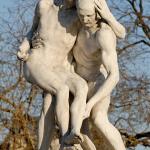A bit over a year after moving into our beautiful new humanities building, there is still a great deal of debate and disagreement for what belongs on the walls. With one notable exception. As I wrote about a year ago, there is one item so omnipresent on the walls in the new building that it is impossible to miss.
Moving day on a Catholic campus is a bit different than on other campuses. The large interdisciplinary program that I direct was moved a couple of months ago into our new fabulous humanities building, an academic Shangri-La that is the envy of my academic friends who teach at other colleges and universities. Since my program’s lectures and seminars will constitute the lion’s share of classes taught in this building, I have been referring to it as “my building” since ground breaking a bit over a year ago. The day after we moved, as I wandered the halls of the Ruane Center for the Humanities and thanked the gods of interdisciplinarity for this long-awaited gift, I came across an unusual sight. ![15267-4259672-6[1]](https://wp-media.patheos.com/blogs/sites/766/2013/10/15267-4259672-61.jpg) In the middle of the main floor hall, piled on top of a pushcart such as food services uses to deliver items to meetings, were at least a dozen identical two-foot crucifixes, in living and gory color. “Must be crucifix day—we certainly are keeping some crucifix factory in business,” I thought. More than twenty-five years as a non-Catholic in Catholic higher education has prepped me for sights never seen on other campuses.
In the middle of the main floor hall, piled on top of a pushcart such as food services uses to deliver items to meetings, were at least a dozen identical two-foot crucifixes, in living and gory color. “Must be crucifix day—we certainly are keeping some crucifix factory in business,” I thought. More than twenty-five years as a non-Catholic in Catholic higher education has prepped me for sights never seen on other campuses.
 But this was a first, and I mentioned it to the next few colleagues I came across as the morning progressed. One faculty colleague told me, as she was setting up her new office, that she had come across a room on the lower level where dozens of crucifixes were laid out across the floor. “It looked like some sort of weird medieval torture chamber.” Another colleague said “Oh yeah. You don’t want to get in front of that train. I did that once, and it wasn’t pretty.”
But this was a first, and I mentioned it to the next few colleagues I came across as the morning progressed. One faculty colleague told me, as she was setting up her new office, that she had come across a room on the lower level where dozens of crucifixes were laid out across the floor. “It looked like some sort of weird medieval torture chamber.” Another colleague said “Oh yeah. You don’t want to get in front of that train. I did that once, and it wasn’t pretty.”  Apparently this colleague found out a couple of years ago during a discussion about the placement of a crucifix in a new classroom that the crucifix always gets priority because “God is more important than white boards.” Good information to have. A couple of days later, as I was giving my son a guided tour through my new building, we came across yet another very large crucifix. “His halo looks like a dinner plate,” my son observed. “It’s a little known fact that when the Romans crucified someone they didn’t just nail the person to the cross.
Apparently this colleague found out a couple of years ago during a discussion about the placement of a crucifix in a new classroom that the crucifix always gets priority because “God is more important than white boards.” Good information to have. A couple of days later, as I was giving my son a guided tour through my new building, we came across yet another very large crucifix. “His halo looks like a dinner plate,” my son observed. “It’s a little known fact that when the Romans crucified someone they didn’t just nail the person to the cross.  They also made him balance a gold plate on his head,” I replied. You can’t get this information just anywhere.
They also made him balance a gold plate on his head,” I replied. You can’t get this information just anywhere.
All this reminded me of a favorite story from a friend and colleague with whom I spent sabbatical at an ecumenical institute a few years ago. He told me about the large Catholic parish church he and his wife attend when home in Washington D.C., a church filled with expensive and gory religious art. Once at a vestry meeting my friend commented that “during mass we say ‘Christ has died, Christ is risen, Christ will come again.’ Anyone visiting this church would have no trouble figuring out that Christ has died; we might want to consider having at least one thing on display that indicates that Christ has risen.”
I must admit that I don’t “get” the attraction of crucifixes; I am quite sure I had made it into my late teens or early twenties before I saw my first cross bearing a corpus. In the world in which I was raised, crosses were empty—that was the point, right?  But before my Protestant bemusement at Catholic practices gets out of control, let me assure you that Protestants are just as capable as Catholics of getting out of control with religious artifacts. In the early years of the Protestant Reformation, mobs of Protestants occasionally stormed through churches destroying all symbols of “popery,” including crucifixes, statues, and often priceless works of art. Several centuries later, there is continuing evidence throughout Protestantism not only of this iconoclastic spirit,
But before my Protestant bemusement at Catholic practices gets out of control, let me assure you that Protestants are just as capable as Catholics of getting out of control with religious artifacts. In the early years of the Protestant Reformation, mobs of Protestants occasionally stormed through churches destroying all symbols of “popery,” including crucifixes, statues, and often priceless works of art. Several centuries later, there is continuing evidence throughout Protestantism not only of this iconoclastic spirit, ![green-cross-neon-sign-6867771[1]](http://wp.production.patheos.com/blogs/freelancechristianity/files/2013/10/green-cross-neon-sign-68677711.jpg?w=150) but also of a remaining, undiluted attachment to religious symbols. Crosses are everywhere, often combining fetishism and bad taste. Neon crosses were particularly popular in the churches I visited with my preacher father as a child, most often an
but also of a remaining, undiluted attachment to religious symbols. Crosses are everywhere, often combining fetishism and bad taste. Neon crosses were particularly popular in the churches I visited with my preacher father as a child, most often an  ethereal blue, but also coming in Kermit the frog green, red, or laser bright white. And don’t get me started on artist’s renditions of Jesus. Let’s just say that whatever the connection is between religious belief and mass-produced items of religious art, it runs far deeper than the divide between Catholics and Protestants.
ethereal blue, but also coming in Kermit the frog green, red, or laser bright white. And don’t get me started on artist’s renditions of Jesus. Let’s just say that whatever the connection is between religious belief and mass-produced items of religious art, it runs far deeper than the divide between Catholics and Protestants.
I have occasionally written in this blog about the difference between idols and icons, the difference between focusing one’s attention on an artifact, object, or work of art and letting that artifact, object, or work of art serve as a doorway or window to something else![Fedorovskaya[1]](https://wp-media.patheos.com/blogs/sites/766/2013/10/fedorovskaya1.jpg?w=114) . The difference between treating something as an idol or as an icon is the difference between “looking at” and “looking through.” To my irreverent Protestant eye, a crucifix is a prime candidate for idolatry, because it is available and oddly attractive. But if I step outside of my admittedly skewed perspective and wonder how a crucifix might be an icon, what lies on the other side of such a sacred window?
. The difference between treating something as an idol or as an icon is the difference between “looking at” and “looking through.” To my irreverent Protestant eye, a crucifix is a prime candidate for idolatry, because it is available and oddly attractive. But if I step outside of my admittedly skewed perspective and wonder how a crucifix might be an icon, what lies on the other side of such a sacred window?
Looking through a crucifix brings suffering and pain into focus, which makes a crucifix a complex symbol of a very complex set of beliefs. At the heart of Christianity is the suffering and dying God, a God who, using Simone Weil’s words, offers a supernatural use for suffering rather than a supernatural cure for it. God’s response to the pain, suffering and devastation of our world and the human experience is to enter it with us, to share the burden. In the most horrific of circumstances God is intimately available. Although a crucifix hanging on a wall is just a mass-manufactured religious artifact,![Pastrix-cover[1]](https://wp-media.patheos.com/blogs/sites/766/2013/10/pastrix-cover1.jpg?w=200) it can be an iconic reminder that there is absolutely nothing that can occur in this frequently messed up world that does not include God’s presence.
it can be an iconic reminder that there is absolutely nothing that can occur in this frequently messed up world that does not include God’s presence.
In her recent memoir Pastrix: The Cranky, Beautiful Faith of a Sinner and Saint, Nadia Bolz-Weber, a heavily tattooed and pierced former stand-up comic who is the Lutheran pastor and founder of the Church of All Saints and Sinners in Denver, CO, tells the story of the ten weeks she spent as a hospital chaplain, satisfying a clinical pastoral education requirement during her years in seminary. What is an apparent representative of God supposed to do when regularly placed in the company of people experiencing the worst pain and sorrow imaginable? Bolz-Weber knew instinctively that words were almost certainly the last thing needed.
You hear a lot of nonsense in hospitals and funeral homes. God had a plan, we just don’t know what it is. Maybe God took your daughter because He needs another angel in heaven. But when I’ve experienced loss and felt so much pain that it feels like nothing else ever existed, ![when_god_closes_a_door_he_opens_a_window[1]](https://wp-media.patheos.com/blogs/sites/766/2013/10/when_god_closes_a_door_he_opens_a_window1.jpg?w=150) the last thing I need is a well-meaning but vapid person saying that when God closes a door he opens a window. It makes me want to ask where exactly that window is so I push him the fuck out of it.
the last thing I need is a well-meaning but vapid person saying that when God closes a door he opens a window. It makes me want to ask where exactly that window is so I push him the fuck out of it.
As she would often sit silently with persons in the midst of great loss in a chapel with a crucifix overhead, Bolz-Weber trusted that the God who was there could communicate far better than words. A crucifix as an icon reminds us that God did not look down on the cross—God was hanging from the cross. This truth transcends doctrine, intellect, and even our best tortured questions. From Pastrix once again:
![Emmanuel_God_With_Us[1]](https://wp-media.patheos.com/blogs/sites/766/2013/10/emmanuel_god_with_us1.jpg?w=150) There simply is no knowable answer to the question of why there is suffering. But there is meaning. And for me that meaning ended up being related to Jesus—Emmanuel—which means “God with us.” We want to go to God for answers, but sometimes what we get is God’s presence.
There simply is no knowable answer to the question of why there is suffering. But there is meaning. And for me that meaning ended up being related to Jesus—Emmanuel—which means “God with us.” We want to go to God for answers, but sometimes what we get is God’s presence.













